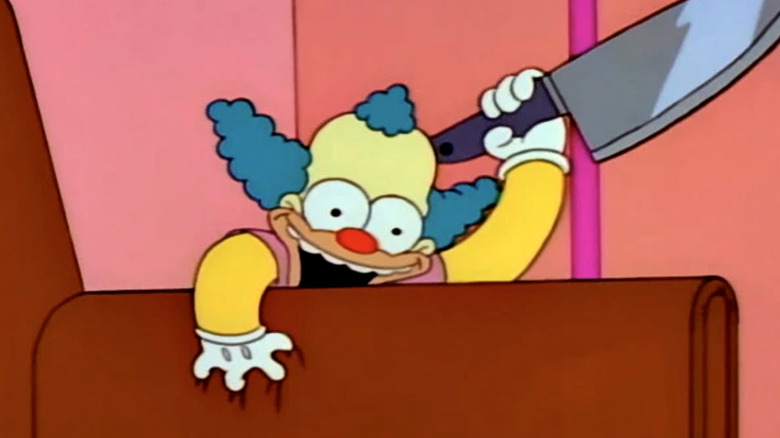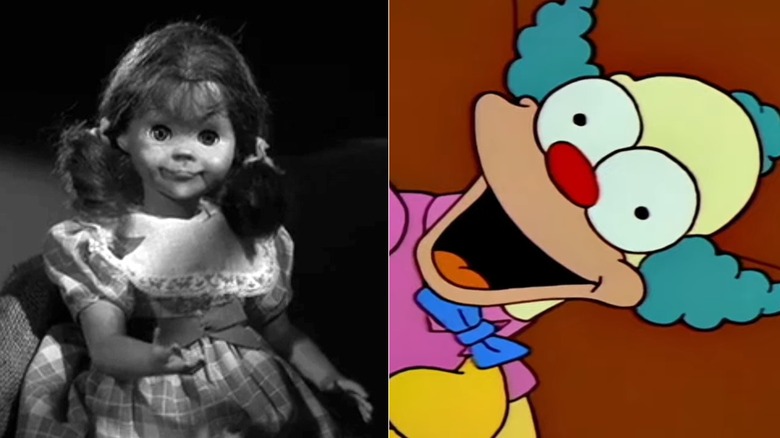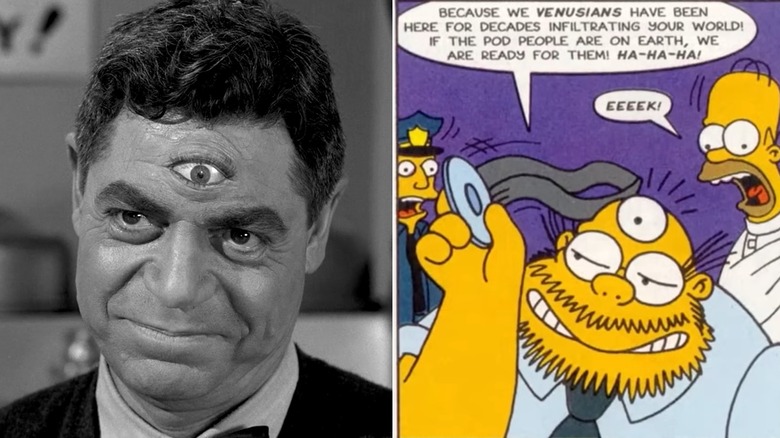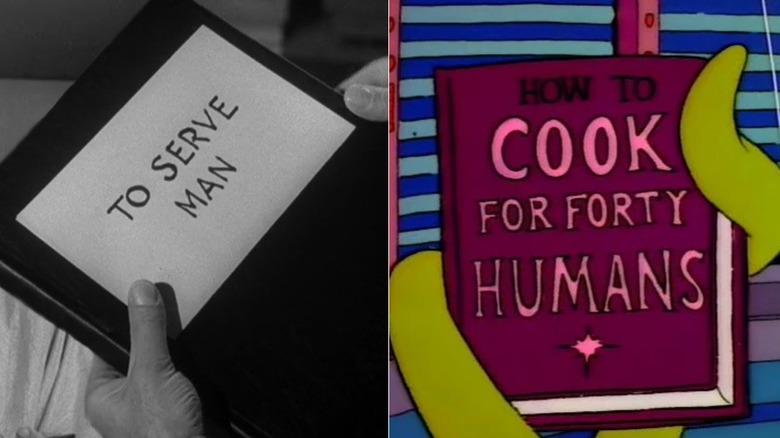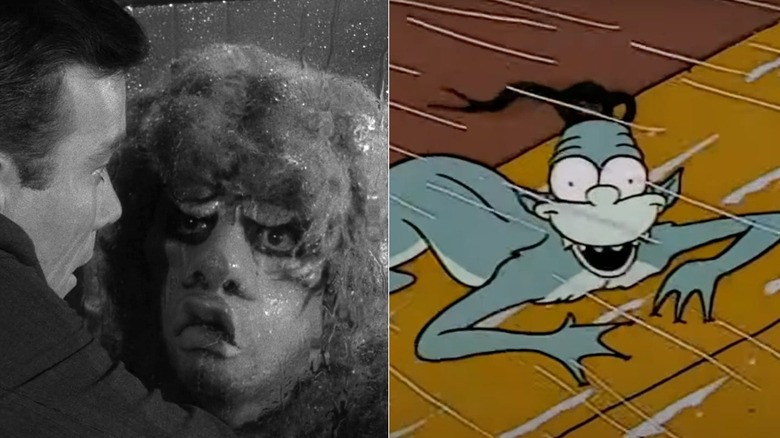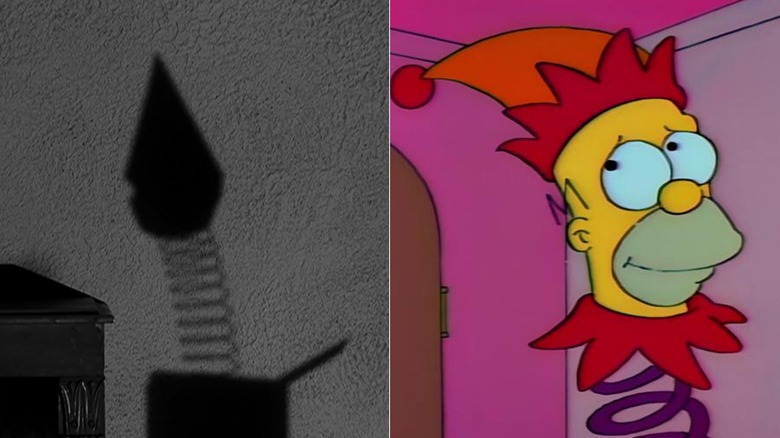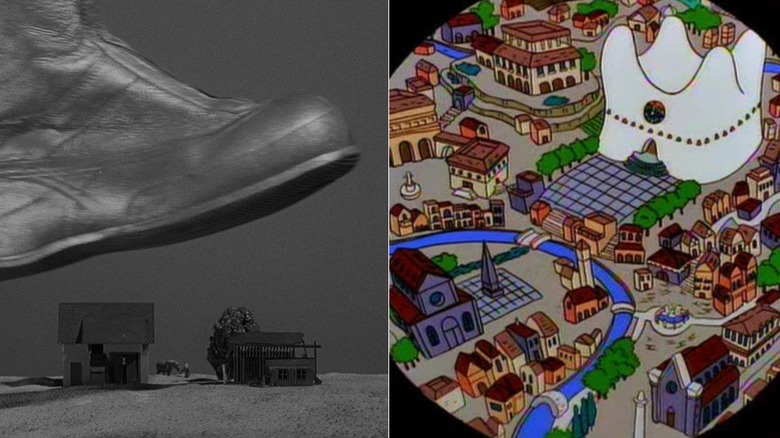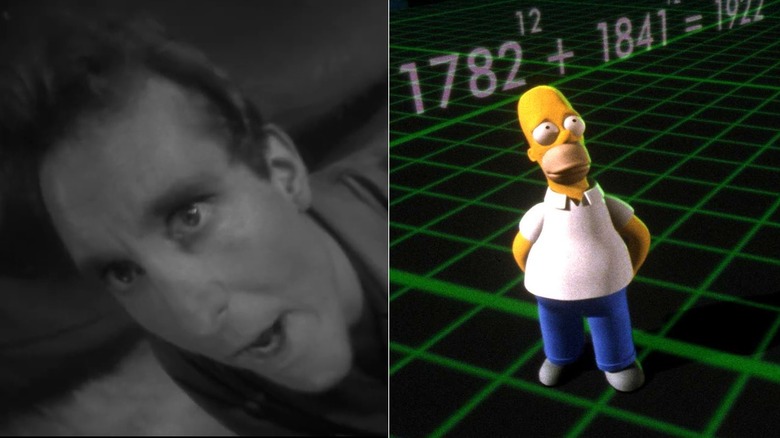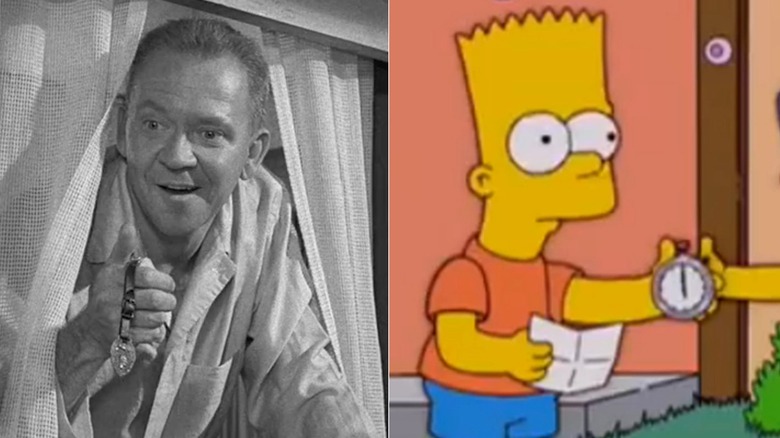Every Time A Simpsons' Treehouse Of Horror Segment Parodied The Twilight Zone, Ranked
One key thing to remember, when watching a "Treehouse of Horror" episode of "The Simpsons," is that everything is a reference to something. Sometimes the thing the show's parodying is instantly recognizable, like season 5's take on "The Shining" or season 2's take on "The Raven." But if you find yourself watching a fun "Treehouse" segment and not recognizing where the story's from, that's a sign that you're missing out on a really fun piece of pop culture.
Such is the case with "The Twilight Zone," a '60s anthology show with 150+ episodes of fun premises to choose from. Some of the episodes "Treehouse" chooses to parody are already extremely famous (I don't think there was ever any confusion over what season 5's "Terror At 5 ½ Feet" was riffing on, for instance) but others are a little more obscure. Below is a ranking of our favorite "Twilight Zone" parodies throughout the "Treehouse" specials. If you're surprised to find that a given segment is from Rod Serling's classic anthology series, take it as a sign that you should check the episode out.
Obligatory disclaimer: we're only including the "Treehouse" segments that heavily parody a specific "Twilight Zone" episode. If we were to cover every reference throughout the entire 35+ season show, or any segment that gave the classic show a quick homage, we'd be here all day.
8. Living Doll/Clown Without Pity
Stories of creepy dolls have been told for centuries by this point, but "The Twilight Zone" brought the concept to TV with "Living Doll," a story about a man who finds himself tormented by his stepdaughter's evil doll, Tina. As has often been the case with these types of stories, nobody believes the man when he tells them the doll's trying to kill him, nor does he do a good job of explaining the situation to them. (Why doesn't he let his wife see what happens when he tries to harm the doll? We'll never know.)
In that sense, "The Simpsons" season 4 improves upon the original, because here Homer is not forced to spend twenty minutes trying in vain to convince Marge that something weird's going on. Although none of us would blame Marge for not believing him (in the episode's funniest line, Homer says "The doll's trying to kill me, and the toaster's been laughing at me!"), Marge gets a handle on the situation pretty early on and calls the doll company to fix the situation. Turns out, there was a switch on the back of the Krusty doll that needed to be flicked from the "evil" to "good" setting.
Tragically, things weren't so easy in "Living Doll," where Talky Tina seemed to be the manifestation of the daughter's resentment of her douchey stepfather, or perhaps a manifestation of the father's self-hatred. That underlying theme gives the "Twilight Zone" episode a sense of direction that "Clown Without Pity" doesn't have, which is why the latter sort of fizzles out at the end while the former finishes strong. But while this segment isn't the show's best "Treehouse" segment, it's still got more than enough laughs to go around.
7. Will the Real Martian Please Stand Up?/The Immigration of the Body Snatchers
Alright, so this one's cheating a little, as "The Immigration of the Body Snatchers" is not an official "Treehouse" segment. It is, however, a story in the show's annual Halloween comic issue, which was titled at the time "Bart Simpson's Treehouse of Horror." This is the third one, published in 1999. Its first segment follows Homer as he pieces together that his town has been invaded by creepy aliens, turning all the townspeople into lazy zombies. This might sound like a good thing for Homer, as it'd mean he won't have to work anymore, but it also means he can't enjoy beer or TV, and for him that's a total dealbreaker.
Although "Immigration of the Body Snatchers" starts off as a straightforward parody of the 1956 (or 1978) classic sci-fi film, "Invasion of the Body Snatchers," the final twist reveals that it's much more of a riff on the classic season 2 "Twilight Zone" episode, "Will the Real Martian Please Stand Up?" From the three-eyed alien to the multi-alien reveal, the comic shows that riffing off "The Twilight Zone" is not just a hobby exclusive to TV "Simpsons." This comic (and most of the "Simpsons" comics, for that matter) is charming, meta, and even faster-paced than a typical "Treehouse" segment. It's definitely worth the read.
6. To Serve Man/Hungry Are The Damned
The 1962 "Twilight Zone" episode "To Serve Man" is basically a parable about man's overly-trusting nature. A bunch of aliens come down to Earth, promise us easy peace and prosperity, and we soon let our guard down enough for them to trick us aboard their spaceships — where they cook and eat us. Sure, the humans in this story are skeptical in the beginning, but ultimately their downfall is that they don't assume the worst of these mysterious outsiders. The episode has a haunting, cynical finale, with an iconic twist that works even if the pun it's based on is pretty silly. (What a tragic coincidence that the Kanamit word for "serve" also has the same two distinct meanings as it does in English!)
"The Simpsons" season 2 takes the wordplay of the classic episode's twist and ramps it up a notch, revealing that the cookbook Lisa finds (seemingly titled "How to Cook Humans") actually has a bunch of inconveniently-placed dust on the cover. This time, the big twist is that the humans weren't trusting enough of the aliens claiming to come in peace. It's a similarly dark ending, as the Simpson family must deal with the guilt of hurting the poor aliens' feelings, not to mention the realization that they totally biffed humanity's first interaction with a higher lifeform. "You would have been treated like gods and lived forever in beauty," the aliens tell them, "But now, because of your distrustful nature, that can never be." Geez, what a downer.
5. Nightmare At 20,000 Feet/Terror At 5 ½ Feet
Ah, "Nightmare at 20,000 Feet." It's such a good concept for an episode, one that will be revisited constantly in pop culture because, well, how could you not? As long as fear of flying's a common phobia, audiences will always be captivated by this story. Any time someone gets on a plane, they do so with the knowledge that they are stuck there for at least a few hours, that they are basically powerless to prevent any disaster that might come.
What's impressive about the spin "The Simpsons" season 5 put on this story is that the schoolbus setting shouldn't work. Bus crashes aren't as high-stakes as plane crashes, after all, nor is the atmosphere in a bus ever as tense as it is in a plane during a turbulent storm. But it's stressful anyway because of how thoroughly the story embraces Bart's kid logic. All the adults truly are useless here, and even though the bus ride to school should surely only last ten, twenty minutes max, the segment gives off the impression that this bus ride's been going on for hours. Time moves slower when you're a kid, and this segment takes full advantage of that feeling.
My only quibble is that I wonder if this story should've centered around Lisa, not Bart. Lisa's the anxious one, after all; her slowly going insane in this situation seems like a perfect fit for her character. Whereas Bart is quick to accept the gremlin's existence, Lisa would've had a whole breakdown when she realized she couldn't logic her way out of what she was seeing. Still, the writers handle the situation just fine with Bart as the main character, giving us one of the snappiest segments in an already strong "Treehouse" episode.
4. It's a Good Life/The Bart Zone
The 1961 episode "It's a Good Life" is all about a family that's terrorized by their troublemaking, all-powerful son, so it was no surprise when "The Simpsons" season 3 chose to have Bart take on that role. The fun of the first half of the segment is that, as terrifying as this all is for the rest of the family, it's a delightful wish fulfilment fantasy as far as Bart's concerned. What would he do if he had total control over the world around him? Well, he'd use it to goof off in school, watch TV, prank call Moe's Tavern, and terrorize his father. It's the same things he always does, but now he can easily get away with it.
What makes "The Bart Zone" so fun is the way it takes advantage of its animated medium. The live-action "Twilight Zone" was forced by its budget and tech limitations to keep most of the evil kid's shenanigans off-screen, whereas "The Simpsons" has the means to show all of Bart's ungodly creations with zero restraint. The implied approach of "The Twilight Zone" is better for horror, sure, but the explicit visual approach of "The Simpsons" is much better for comedy. The ungodly creature Bart turns Snowball into is delightful, for instance, because you can so easily see how a 10-year-old would find it hilarious while everyone else is filled with terror.
The segment's funniest twist is the reveal that Bart's idea of a horrifying, devastating ending is him having a nice moment with his father. Bart and Homer get the happy ending "The Twilight Zone" tragically denied the magical kid's family, but Bart's not interested in it for a second.
3. The Little People/The Genesis Tub
This is one of the looser parodies: both stories feature a miniature society, but they handle it in two very different ways. The titular Little People in "The Twilight Zone" don't advance through technology that quickly, for instance, and the tub people in "The Simpsons" season 8 aren't nearly as helpless. The main similarity is the way both stories feature a good and evil human, one who has sympathy for the microcivilization's plight and one who sees them as an easy target to bully. Navigator Craig from "The Twilight Zone" is motivated by his lust for power, his need to have his ego flattered by people below him; Bart is motivated more by spite and carelessness. He casually murders thousands of tiny people early on just for fun, and then tries to commit full-on genocide when the tub people strike back at him.
Where "The Simpsons" improves on its source material is in the way it holds Lisa accountable. When Bart murders thousands of the microscopic people, Lisa calls it "rude" like it's just another one of his pranks, and then dismisses Bart as "just" her brother when she gets to speak to the tooth people directly. It feels like commentary on how the original episode's "good guy" Commander Fletcher still abandons the Little People to their fates at the end. He feels sorry for the ego-tripping Craig, and he does show some basic sympathy towards the Little People, but he still leaves them to deal with their new sadistic god, putting up no real fight to save them. The "Simpsons" writers seemed to have also been bothered by this apathy, as it takes the time to interrogate how this behavior might look from the tub people's perspective.
2. Little Girl Lost/Homer Cubed
The season 3 "Twilight Zone" episode centers around a little girl who accidentally falls through a portal to the fourth dimension, one that's just sort of popped up in the wall behind her bed. What follows is a spooky installment with some genuinely great visuals in the final act, showing us what the fourth dimension actually looks like. The show used every cool camera trick in the book to make the experience as unnerving and immersive as possible, and it still holds up even sixty years later.
The animation in the "Simpsons" parody doesn't hold up quite as well, but it's still appropriately eerie and fascinating to look at. Here, it's not a helpless little girl trapped in the other dimension but the closest thing to it: Homer J. Simpson, who tried to hide behind a bookshelf and found himself trapped in a terrifying three-dimensional world. (Could you imagine?) The world here looks a bit like the one in "Tron," not that anyone here has ever seen it.
Thanks to the much bigger budget of "The Simpsons" season 7, we could see a lot more of how physics worked in this bizarre dimension Homer finds himself in, whereas "The Twilight Zone" was limited to just one scene. And as tends to be the case in these "Treehouse" segments, Bart really shines here. Whereas the original episode took an agonizingly long time before someone stepped into the portal to try to rescue the little girl, here Bart ignores the experts and just runs in with a rope tied to him. Okay, so Bart doesn't succeed in saving the day, but it's the thought that counts.
1. A Kind Of A Stopwatch/Stop The World, I Want To Goof Off
It makes sense that "The Simpsons" season 16 would want to riff on this episode, because the 1964 episode "A Kind of a Stopwatch" has so much missed potential. It takes eight full minutes before the main character gets his hand on the magical time-freezing stopwatch, and it takes another ten minutes before the main character does something interesting with it. This story should be centered around a competent schemer-type character, but "The Twilight Zone" centers it around a charmless idiot named McNulty, a guy who only manages to come up with one wish-fulfilment scheme (robbing a bank without anyone seeing or noticing him) which instantly backfires, then the episode's over.
Meanwhile, "The Simpsons" gives the magic stopwatch to Bart within a minute, and he starts having fun with it right away. He and Milhouse spend most of the segment pranking everyone in their midst, causing absolute chaos throughout Springfield (and nearly driving Homer to suicide) by the time the watch inevitably breaks and leaves them trapped in frozen time. This entire section of the episode feels like something from the golden age of "The Simpsons," firing a million jokes a minute and not missing any of them. While "The Twilight Zone" squandered its golden premise, this segment insists on making the most of it.
Of all the characters to center this short around, Bart's the smartest choice. Homer would've used the stopwatch to satisfy straightforward adult desires like stealing free beer, Lisa would've used it to study more, and Marge would've refused it entirely. Only Bart could've made this segment as entertaining as it was. It's not the spookiest "Treehouse" segment, but it's easily one of the funniest and most inventive.
